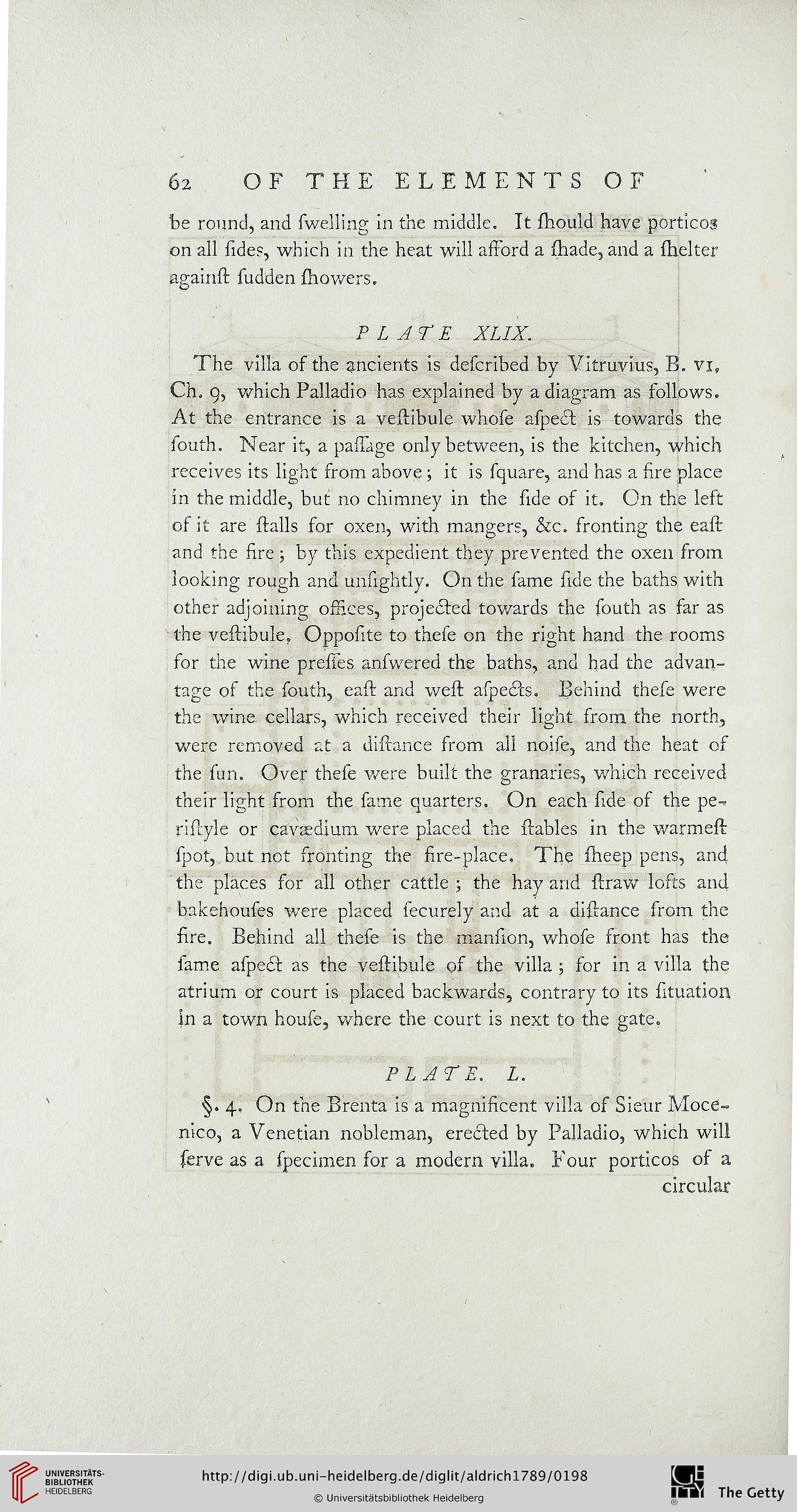62
OF THE ELEMENTS OF
be round, and swelling in the middle. It should have porticos
on all side?, which in the heat will afsord a shade, and a shelter
against sudden showers,
PLATE XL1X.
The villa of the ancients is described by Vitruvius, B. vi9
Ch. 9, which Palladio has explained by a diagram as follows.
At the entrance is a veilibule whose aspect is towards the
south. Near it, a passage only between, is the kitchen, which
receives its light srom above ; it is square, and has a fire place
in the middle, but no chimney in the side of it. On the left
of it are slails for oxen, with mangers, &c. fronting the east:
and the fire ; by this expedient they prevented the oxen from
looking rough and unsightly. On the same side the baths with
other adjoining ofsices, projected towards the south as far as
the vestibule. Opposte to these on the right hand the rooms
for the wine presses answered the baths, and had the advan-
tage of the south, east and west aspecfts. Behind these were
the wine cellars, which received their light from the north,
were removed at a distance from all noise, and the heat of
the sun. Over these were built the granaries, which received
their light from the same quarters. On each side of the pe-
ristyle or cavredium were placed the stables in the warmest
spot, but not sronting the fire-place. The sheep pens, and
the places for all other cattle ; the hay and straw losts and
bakehouses were placed securely and at a distance srom the
fire. Behind all these is the manson, whose sront has the
lame aspedt as the vestibule os the villa ; for in a villa the
atrium or court is placed backwards, contrary to its sttuation
in a town house, where the court is next to the gate.
PLATE. L.
§. 4. On the Brenta is a magnificent villa of Sieur Moce-
mco, a Venetian nobleman, eredted by Palladio, which will
serve as a specimen for a modern villa. Four porticos of a
circular
OF THE ELEMENTS OF
be round, and swelling in the middle. It should have porticos
on all side?, which in the heat will afsord a shade, and a shelter
against sudden showers,
PLATE XL1X.
The villa of the ancients is described by Vitruvius, B. vi9
Ch. 9, which Palladio has explained by a diagram as follows.
At the entrance is a veilibule whose aspect is towards the
south. Near it, a passage only between, is the kitchen, which
receives its light srom above ; it is square, and has a fire place
in the middle, but no chimney in the side of it. On the left
of it are slails for oxen, with mangers, &c. fronting the east:
and the fire ; by this expedient they prevented the oxen from
looking rough and unsightly. On the same side the baths with
other adjoining ofsices, projected towards the south as far as
the vestibule. Opposte to these on the right hand the rooms
for the wine presses answered the baths, and had the advan-
tage of the south, east and west aspecfts. Behind these were
the wine cellars, which received their light from the north,
were removed at a distance from all noise, and the heat of
the sun. Over these were built the granaries, which received
their light from the same quarters. On each side of the pe-
ristyle or cavredium were placed the stables in the warmest
spot, but not sronting the fire-place. The sheep pens, and
the places for all other cattle ; the hay and straw losts and
bakehouses were placed securely and at a distance srom the
fire. Behind all these is the manson, whose sront has the
lame aspedt as the vestibule os the villa ; for in a villa the
atrium or court is placed backwards, contrary to its sttuation
in a town house, where the court is next to the gate.
PLATE. L.
§. 4. On the Brenta is a magnificent villa of Sieur Moce-
mco, a Venetian nobleman, eredted by Palladio, which will
serve as a specimen for a modern villa. Four porticos of a
circular





